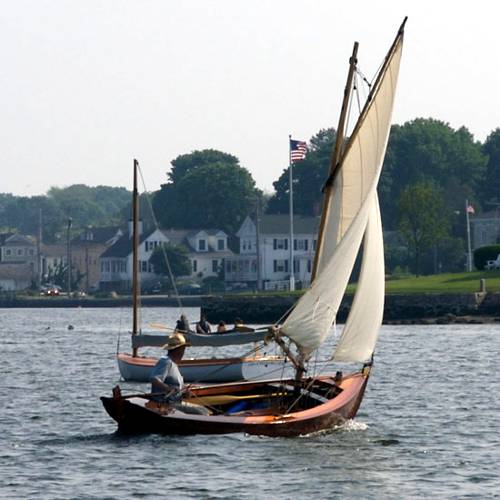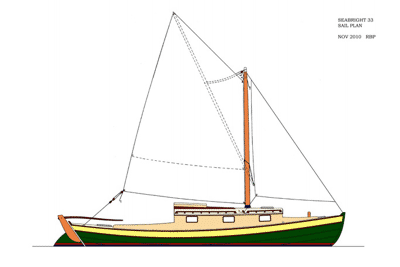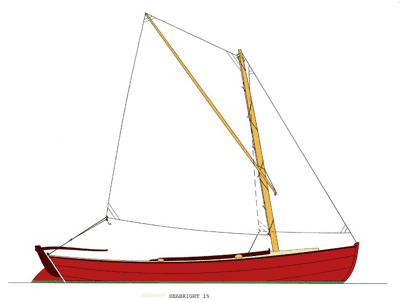Jersey Beach Skiffs |
|---|
 |
The Sea Bright Skiff: Working on the Jersey Shore
|
THE SEABRIGHT SERIES—Design Commentary by Reuel B. Parker
|
 |
|
The motivation to design the original vessel in this series—the 18-footer—came from several sources: I have always had an interest in small craft that can make ocean passages safely, and have read everything I came across on that subject. I like beach cruising with camping gear, and I like a reasonable degree of comfort. Over the years several of my friends have asked me to design "pocket cruisers" along dory and sharpie lines. Most recently, I read Webb Chiles' The Ocean Waits, and became immediately inspired to design a similar size vessel which would overcome what I perceive to be shortcomings in the design, construction and accommodations of Chiles' Drascomb Lugger, Chidiock Tichborne. Specifically, I set out to design a comfortable, safe, seaworthy, versatile microcruiser capable of extended offshore passages as well as being trailerable and beachable. For the hull model, I worked from three historic types: The triple-chine New England surf dory, the salmon wherry, and the New Jersey (Seabright) beach skiff. I opted for a planked skeg and wide-plank bottom (box-keel), typical of the latter two types, because of stability standing free (whether on the beach, reef or trailer), and because the wide, rockered skeg will not dig into soft sand or mud, making the boat hard to move when grounded or beached. I opted for foil-shaped, kick-up centerboard and rudder for safety in grounding and ease of beaching. The centerboard lever cannot jam in the trunk, and lies on top of the trunk when the board is up. Construction is plywood, one of three methods: chine-batten, stitch-and-glue, or lapstrake. The bottom plank should be thicker plywood than the side planks. Bulkheads, decks and platforms are also plywood, and I would cover all exterior surfaces with Xynole-polyester cloth and epoxy. The hull is built around the main bulkheads (design stations), which are epoxy filleted and polyester-taped to the hull. There are several independent closed compartments in the hulls, all of which may be watertight with or without access plates. The area forward in all four designs may be covered with a continuous thwart-height platform (or Vee-berth). You may install integral or bladder-type water tanks, both for ballast and fresh water. The thwart compartment(s) may be lined with epoxy/fabric-covered 2" 4-lb. density closed-cell polyurethane foam, for ice and perishable foods. In way of accommodation, the large platform functions as a full double bed. It may be covered with 2" closed-cell polyurethane foam, which will not absorb water, or with 4” mattress foam in the 23’er. The platforms on the smaller Seabright Skiffs may be covered by a removable pipe frame, which allows sitting headroom for two at the aft end. The boat can be rowed sitting partially under this cover, or steered under sail using tiller ropes. A large zippered Mylar flap at the forward end acts as a windscoop when raised and as a window when closed. Screens are zippered in this aperture (when open) and at the after end for sleeping. Nets are rigged port and starboard under the side decks forward for clothing and bedding. A scuppered well deck forward contains the anchor, rode, and painter, with a stout mooring bitt. The stem can be slotted for the anchor rode, with a bail over the top to contain the rode and act as fairlead for the balance jib pennant, the end of which is a large eye splice dropped over the bitt when in use. The 23’er uses a flying jib, with the tack line rove through a hole in the stem head. The halyard is rove through a Delrin sheave let into the masthead. The vessels in this series are as follows: 13.5’, 15’, 18’, 23’ and 50’. The 50’er is the Seabright/Lorcha 50, the prototype of which is Reuel Parker’s live-aboard home T’ien Hou. The first three small craft are open boats which may be fitted with covers and used for camping as described above. These are very seaworthy small craft, particularly if built with water-tight compartments. The 50’er is a ketch-rigged flush deck cruising boat of light displacement, capable of ocean cruising anywhere in the world. There will be more boats designed for this series when time permits: the type is very seaworthy, simple and economical to build, easily-driven under sail or power, and very economical to own, operate and maintain. For more information and plans prices on these and other designs visit Parker Marine's website |

